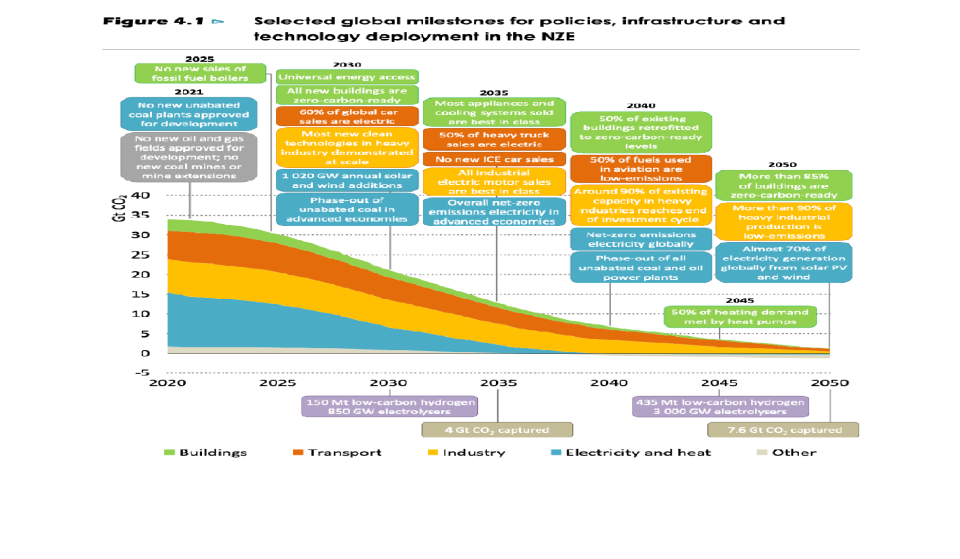- Actions must keep pace with words to achieve net zero by 2050;
- The world is currently on path for 2.5 ˚C to 3 ˚C global warming
“A string of global shocks has likely put 2030 emissions reduction targets out of reach,” says Woodmac. However, with decisive action, there is still time to reach net zero emissions by 2050, this is as Wood Mackenzie’s Outlook takes a constructive swipe at the global journey so far towards a lower carbon future.
The new report has presented four different pathways for the energy and natural resources sector – and that’s Wood Mackenzie’s base case (2.5-degrees), country pledges scenario (2-degrees), net zero 2050 scenario (1.5-degrees) and delayed transition scenario (3-degrees).
It also made key findings to strengthen its forecast that about US$78 trillion of cumulative investment would be required across power supply, grid infrastructure, critical minerals and emerging technologies and upstream to be able to meet Paris Agreement goals.
Noting that energy demand, on the global scale, is set to grow strongly, consequent upon rising incomes, population and the emergence of new sources of demand, which includes data centres and transport electrification.
This is while maintaining that strong renewables growth was inevitable, a situation it underlined would continue under all scenarios modelled in the update. Positing that renewables capacity will grow two-fold by 2030 in the base case, short of the global pledge made at COP28 to triple renewables by 2030.
Maintaining that oil and gas are still going to play their conventional roles in the global energy system to 2050, forecasting however an improvement in innovation to also improve the commerciality of carbon capture and low-carbon hydrogen and derivatives, with record uptake of 6 Btpa and 0.45 Btpa by 2050.
It adds that policy certainty cannot be taken for granted as it is crucial to helping unlock demand for new technologies while increasing capital flow into all segments, including supply chains and critical minerals.
Prakash Sharma, VP, Head of Scenarios and Technologies said: “A string of shocks to global markets threaten to derail the progress in a decade pivotal to the energy transition. From the unresolved war between Russia and Ukraine to an escalated conflict in the Middle East, as well as rising populism in Europe and global trade tensions with China, the energy transition is in a precarious place and 2030 emissions reduction targets are slipping out of hand.” “However, there is still time for the world to reach net zero emissions by 2050 – provided decisive action is taken now. Failure to do so risks putting even a 2 ˚C goal out of reach, potentially increasing warming to 2.5 ˚C – 3 ˚C trajectory.
“We are under no illusion as to how challenging the net zero transition will be, given the fact that fossil fuels are widely available, cost-competitive and deeply embedded in today’s complex energy system,” added Sharma. “A price on carbon maybe the most effective way to drive emissions reduction but it’s hard to see it coming together in a polarized environment. We believe that these challenges are overcome with policy certainty and global cooperation to double annual investments in energy supply to US$3.5 trillion by 2050 in our net zero scenario.”
On electrification as an acceleration route to energy efficiency and peak emissions, the report underlines the urgent need for a quicker electrification of the energy system which, in Wood Mackenzie’s base case, has the potential to displace fossil fuels progressively. This it said would be accompanied with more energy-efficient electricity leads to global emissions peaking in 2027 and subsequently falling by 35% through to 2050.
It also projects global final energy demand to grow by up to 14% by 2050, with emerging economies with rising population density and prosperity growth to reach 45%, while demand in developed economies peaks in the early 2030s and enters a decline. Reshoring of manufacturing (supply chains, cleantech, semi-conductor chips), green hydrogen and electric vehicles to support demand growth, particularly in the US and Europe. Again adding AI and the build-out of data centres as new growth concerns, increasing electricity consumption from 500 TWh in 2023 to up to 4,500 TWh by 2050.
“While electrification is at the heart of energy security, the quick expansion of electricity supply is often constrained by transmission infrastructure which takes time to permit and build,” says Sharma. “Recognizing these challenges, we modelled different electrification rates in our energy modelling. Electricity’s share of final energy demand steadily rises from 23% today to 35% by 2050 in our base case. And, in an accelerated transition such as our net zero scenario, the share of electricity increases to 55% by 2050.”
The share of solar and wind in global power supply increased from 4.5% in 2015 to 17% in 2024. For solar has shown its capacity to serve as the biggest contributor of renewable electricity moving forward, followed by wind, nuclear (including large and small reactors) and hydro – that with all this together, the renewables’ share will rise from 41% at the moment up to 58% by 2030 and up to 90% by 2050, depending on the scenario. “But any number of challenges – from the supply chain, critical minerals supply, permitting and power grid expansion – could dampen aspirations for renewables capacity,” Sharma said.
Woodmac further posited that energy transition technologies were three-to-five times more metals intensive and often requiring different materials than legacy commodities, such as lithium, nickel, cobalt and rare earth elements. Adding that battery demand will rise five- to ten-fold in the base case and net zero scenario, respectively, by 2050.
Meanwhile, nuclear’s ability to supply zero-carbon electricity round-the-clock is finding favour, with technology companies building data centres capacity, Woods said. This is while returning to policy support systems for both new power projects and uranium supply which seemed to have expanded over the past year as a sine-qua-non. “The opportunity is huge, but the nuclear industry will need to overcome its cost and chronic project delays to stay competitive with other forms of power generation.” Woods projects nuclear capacity to double in its base case and triple in its net zero scenario by 2050, compared with 383 GW last year.
On fossil fuels rise or fall, Woods said: “Despite strong growth in renewables, the transition has been slower than expected in certain areas because many low-carbon technologies are not yet mature, scalable, or affordable,” said Sharma. “A key constraint is the high cost of low-carbon hydrogen, CCUS, SMR nuclear, long-duration energy storage, and geothermal. Capital intensity is high, but the business case is weak without incentives.”
Adding that this challenge is coming at a time of strong energy demand growth. This is while noting that as renewables alone will not be able to meet future energy needs in most markets, oil and gas is projected to continue playing a role in the global energy system to 2050.
Commercializing low-carbon energy development which poses numerous challenges Woods said is also coming, unfortunately, at a time of strong energy demand growth.
Sharma said: “Our analysis shows that with demand resilient, investment in upstream will be needed for at least the next 10 to 15 years to offset the natural depletion in onstream supply.” “Capital requirements for oil and gas increase significantly in the delayed transition scenario, in which costs of new technologies fall slowly, and policy support remains muted.
Meanwhile, liquids demand will peak at 106 mb/d by 2030 in the base case, but that comes with a 12% variation on either side, depending on the scenario, which also highlights the degree of uncertainty for the oil and gas sector, driven by the pace of penetration of EVs in road transport, e-fuels in shipping and aviation, and industrial heat pumps. Demand will stay high at 100 mb/d levels until 2047 in the delayed transition scenario but in a net zero world, falls rapidly to 32 mb/d by 2050.
More than 1,200 projects Woods said have already been announced in both the CCUS and hydrogen sectors in the past five years. However, few have taken FID yet due to a lack of policy certainty and high costs. Projects moving into development have an equity-adjusted IRR of well below cost of capital without subsidies. In contrast, upstream oil and gas projects remain attractive at 15% IRR or even higher at an industry planning price of US$65/bbl Brent long-term. Capital allocation and finance continue to favour oil and gas projects in the base case.
Woods sees the first global stocktake (GST), concluded at COP28 in November 2023, which also required that countries raised their ambitions in the next round of nationally determined contributions (NDC) submissions, due in 2025. The GST also found that no major country was on track to meet its 2030 goals, which it said leaves an opportunity both for course correction in the next NDC round and for higher emissions-reduction goals for 2035.
“But this will not be easy without increased cooperation at the COP29 meeting in Azerbaijan in November 2024,” says Sharma. “Key issues include finalizing Article 6 of carbon markets and setting a new global climate finance goal that replaces the existing US$100 billion a year. That figure was not achieved until 2022 and is considered grossly insufficient to meet the needs of the developing countries.
“Strengthened NDCs and global cooperation will be crucial to mobilize US$3.5 trillion annual investment into low-carbon energy supply and infrastructure, including critical minerals. If these challenges can’t be overcome, the goal of net zero emissions by 2050 will not be achieved. Among the implications of a delayed transition are the worsening effects of global warming that will force governments not only to invest in mitigation but spend much more on adaptation.”
Ejekwu with Agency Report

